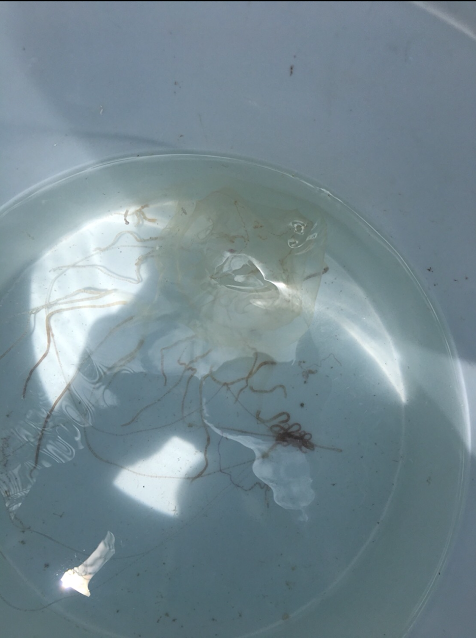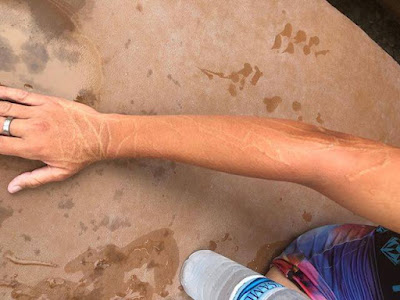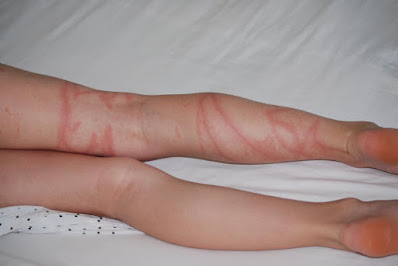How Safe Is Samui? - December 2025 Update Including Koh Phangan
To view the full 2015 How Safe Is Samui? with comments article click here
The local authorities, if this is accurate, report of 12 box jellyfish stings around Koh Samui for the year up to October, 2015 including the death of a 20-year old German woman. These stings have occurred at Chaweng, Lamai, Mae Nam, Lipa Noi and on Ang Thong island. Nearby Koh Phangan also reports stings including two fatalities in the past 12 months.
While there is of course a problem and ignoring signs is plain stupid, there is no need to panic. Be vigilant, ask questions, use common sense, take precautions and heed the warning signs (unlike the couple in the photo below putting themselves at serious risk the day after a death at this beach - if it had been a shark attack fatality and the sign said 'Killer Shark. Very Dangerous' they'd be having that drink in the pool). Also note that day or night, there is always a risk.
Somewhere in the figure of 500,000 visit Koh Samui every year. The equation could be simplified guessing that if half enter the sea for a swim or snorkel then the risk, based on 12 stings this year, would be around 1 in 15,000. Being killed by a jellyfish? 1 in 180,000. This is not to trivialise the problem as the truth is, that '1' could be you!
We take proper precautions (or should) when riding a motor bike, walking across the street, using a power tool, jumping out of a plane, whatever. So to not be that '1' we wear a helmet and follow the rules, look to the left-right and make sure the road is clear, use protective eyewear and gloves, wear a parachute! Accidents will happen but taking the right precautions will minimise the risk.
Further Reading:
The same goes with the threat of being stung by a box jellyfish. If you wear a protective lycra suit when entering the water your chances of being stung are almost nothing. Just about every marine biologist entering tropical seas wears a suit because they know better; they choose life, not a tan.
Get a suntan on the sand, wear a suit in the sea. There's plenty of info on this blog about suits.
Further Reading:Carry a cheap bottle of vinegar in your beach bag. If there is a sting, immediately splash the sting area with vinegar. Do not try and remove the tentacles - don't touch them. Use CPR if the victim requires it. After around 30 seconds of splashing vinegar, the tentacle's stinging cells will be de-activated and you can remove them with seawater. Immediately seek medical assistance.
Further Reading:The venom of some species of box jellyfish can be lethal and can kill in minutes. The Chironex box jellyfish - or Sea Wasp - is widely regarded as the deadliest animal on the planet. Box jellyfish live in tropical seas throughout South-East Asia and Australia and other parts of the world including Hawaii, The Caribbean, Pacific Islands, Indian Ocean and the Persian Gulf. Stings including deaths have been reported in numerous places in Thailand from the Gulf of Thailand to the Andaman Sea. While Koh Samui is now the focus, the risk is no less great at many other beaches across the country.
Unfortunately, little is known about exactly where box jellyfish are in Thailand or if there is a season where they are more common. Research is minimal. No-one knows for certain about what species of box jellyfish is causing the damage. It is a big one. It has multiple tentacles, is highly toxic and is possibly related to Australia's notorious Chironex Fleckeri.
[Postscript 2017: scientific research has increased in the area and it is now known that a deadly species of Chironex box jellyfish that is native to Thailand lives in Samui waters and is responsible for serious and fatal stings. Chironex indrasaksajiae Sucharitakul sp..]
So whether it is Chaweng or Lamai beach or anywhere else along the Samui coast, it seems there is box jellyfish habitat. How many are there? No-one knows. What is known is that box jellyfish can swim (not float) at a speed of around 3 knots. They are brainless but have a visual system of navigation (eyes with retinas, lenses, corneas) that guide them past obstacles such as rocks, nets and slow-moving human legs. They are almost completely transparent so very difficult to see in the water even if it is clear. They hunt for small fish and shrimp in very shallow, sandy-bottom water close to the shore. The media often refers to a jellyfish 'attack' but all human stings are accidental. It is unsuspecting people making contact with the jellyfish, not vica-versa.
Further Reading:
So, is it safe to swim at Koh Samui - or for that matter in other coastal areas of Thailand? The answer is not a simple yes or no. The risk remains no different now than what it was 6 months or 6 years ago. Thousands of happy holiday makers have come and gone leaving with nothing worse than sunburn.
If a sign warning of 'Dangerous Jellyfish' is at one beach and not another, does this mean the beach with no sign is safer? No. The sign just tells us what we already know. Somewhere out there are box jellyfish. The temporarily signed beach might have had a recent sting and common sense would say 'stay out of the water' for at least a day or two.
Thailand has responded and established a permanent plan to inform visitors and minimize the risk. Warning and information signs plus vinegar stations and seasonal prevention nets strategically placed around the island are the frontline of defence against further pain and tragedy. It works in Australia, and it now works in Thailand. People still enjoy spending time in the sea. They are informed, make a choice and have vinegar right there on the beach just in case. There are reports of success and lives being saved.Further Reading:
UPDATE DECEMBER, 2025:
2. TREAT THE VICTIM - use CPR if needed to keep the victim alive if not breathing and/or no pulse
3. TREAT THE STING - apply vinegar by pouring on sting area for 30-60 seconds
4. TRANSPORT - get the victim to hospital or the doctor as soon as possible
- While there's likely been incidents this year, we have not heard anything official regarding stings as of the start of May 2025. No news is good news, hopefully.
- September 2024 stings were reported involving several dangerous box jellyfish species on Samui's north-east beaches.
- July and August 2024 saw increased activity with sightings and stings, including several requiring hospitalization, recorded at Mae Nam beach and Chaweng beach.
- It's not the season and it's been mainly quiet to start 2024. Things will get busier come the second quarter, please take care.
- Several reports of extremely serious and traumatic stings around Koh Samui and Koh Phangan during the latter quarter of 2023. Hospitalisation required with morphine administered for pain relief and treatment will be ongoing to avoid the high risk of infection and serious scarring.
- Same applies in September 2023. There is no shortage of box jellyfish around Samui, tourist numbers are growing and stings are occurring. A reader recently commented here about their scary and painful experience. The problem's not going away, please take the proper precautions.
- There is no let-up in box jellyfish activity occurring in the area with reports of stings over June - August 2023. Remain vigilant and take precautions.
- Official reports continue from late-2022 through early-2023 of multi-tenticle box jellyfish stings requiring treatment. People are swimming outside designated netted areas and being stung. There are no reports of stings to people positioned within prevention net confines.
- Box jellyfish warnings are in place for Kohs Samui and Phangan for October 2022. The alert has been raised after a consistent number of stings, some serious with hospitalisation and a ventilator involved, were reported on both islands. The rainy/monsoon season is not abating soon and box jellyfish are expected to remain in local shallow waters for a longer period than usual. Please pay attention to signage and take preventative measures to lower the risk.
- June, July and August 2022 saw a concerning number of stings, hospitalisations and genuine reports of sightings around the island including a serious sting outside the Lamai Beach net. A boy on Koh Phangan recently died doing just that and the risk can not be understated. Please, follow the warning signs and swim within the net or wear a lycra stinger suit to avoid a potentially nasty box jellyfish confrontation.
- April 2022 saw several reports of box jellyfish stings requiring treatment and in some cases hospitalisation on Koh Samui. Stings were also reported on Koh Lanta and Koh Mak prompting authorities to issue warnings. They have expressed concerns about an increase in sightings and stings across Thailand in recent months.
- A nine-year old Israeli boy has died receiving a fatal box jellyfish sting on Haad Rin beach on Koh Phangan. The tragic incident occurred on Saturday 28 August, 2021. Read Further Details
- The most recent reports of multi-tentacle box jellyfish stings causing injury for July were in the Crystal Bay and Chaweng Noi areas. Over the next few months there is an expected increase in box jellyfish numbers around Koh Samui and neighbouring islands.
- In March/April/May 2021 stings occurred at Taling Ngam Beach, Nathon and the west coast of Samui. Also, near Koh Samui Hospital.
- Two people were stung at Bangrak Beach in February, 2021.
- Box jellyfish stings have been reported on Koh Samui in December, 2020.
- Local authorities issued a warning at the beginning of the 'epidemic season' (July - October 2020) that has historically seen a dramatic increase in box jellyfish sightings and stings the area. Stings and sightings at Koh Tao, Koh Phangan and Koh Samui were reported in that period.
- Novel coronavirus lockdown and restrictions have had well-documented serious travel and tourism implications around the world and Koh Samui is no different.
- A box jellyfish information seminar was held at Haad Salad, Koh Phangan on 30 August, 2020 where attendees were reminded of the dangers and risks and proper prevention and treatment processes by local dive expert and box jellyfish safety advocate, Camille Lemmens.
Latest Links:
- There were a number of serious stings with CPR involved at Chaweng mid-November 2019. All victims which included children were admitted to hospital. One of the young victims received terrible stings and was lucky to survive. He was air-lifted to Bangkok in an induced coma. Koh Phangan also in this period reported stings.
- Thai media reported on 30 October, 2019 that a 10-year old Russian male was stung by a box jellyfish in the morning while swimming at Lamai beach. The boy was immediately attended to by the emergency rescue team and rushed to hospital where he was treated and kept in for observation overnight.
- The Vice President of the Tourism Association of Koh Samui, Krissana Pornhonkoh, was quoted as saying that from July to October box jellyfish are "especially rampant" with 8 box jellyfish stings having been reported so far this year (2019), lower than previous years, and no fatalities.
 |
| Highly venomous box jellyfish collected in the Lamai beach area July 2018 |
Official Koh Phangan Warning - September 2018:
INCASE OF AN EMERGENCY CALL 1669# (Jellyfish stings on Koh Samui and Koh Phangan only).
At the time of this update there have been no recently reported deaths in this corner of the Gulf of Thailand though there have been reports of box jellyfish sightings, specimen collections and stings requiring hospitalisation. Sadly, there there was a fatality on the east side of the Gulf in July 2020. Deadly box jellyfish are present and the risk remains real.
In mid-2017, two stinger prevention nets were installed at Koh Samui. One is located at Lamai Beach and the second was installed at Chaweng Beach. At 100m long and 7 metres deep, these nets have been tested by local authorities and are believed to be safe. Unfortunately though, the net at Chaweng has been permanently removed. This is an initiative of Thailand's Marine & Coastal Resources Department (in conjunction with the Koh Samui Municipality and Koh Samui Tourism Association) who have been monitoring the nets' effectiveness. Please observe warning and information signs.NOTE: Having been removed for maintenance, the net at Lamai was re-installed on 4 July 2019 for what local authorities believe is a 6-month box jellyfish 'epidemic season'. Stings have however already been reported starting July 2019.
Further Reading:
Staff of Thailand's Marine & Coastal Resources Department conduct regular (not sure how regular) sweeps with nets in the shallows of certain popular Samui beaches. Wearing full body lycra stinger suits and rubber gloves as protection, they continue to catch the lethal Chironex-type box jellyfish.
An official warning was issued September 2018 by the Governor of Surat Thani to avoid swimming at Chalok Lam Bay, Koh Phangan after a large number of box jellyfish sightings.
NOTE: Having been removed for maintenance, the net at Haad Rin was re-installed on 4 July 2019 for what local authorities believe is a 6-month box jellyfish 'epidemic season'.
 |
| Box jellyfish sting Lamai 10 August 2018 - Source Thaivisa |
 |
| Box jellyfish sting Lamai 10 August 2018 - Source Thaivisa |
PLEASE NOTE if you or someone gets a sting:
2. TREAT THE VICTIM - use CPR if needed to keep the victim alive if not breathing and/or no pulse
3. TREAT THE STING - apply vinegar by pouring on sting area for 30-60 seconds
4. TRANSPORT - get the victim to hospital or the doctor as soon as possible
Further Reading:
Camille Lemmens is a diving instructor and long-time resident of Koh Samui. He is a strong advocate for water safety in Thailand and is actively working with the local community and authorities to improve box jellyfish awareness and safety. Check out Camille's Samui Info Blog to get the latest on Box Jellyfish activities including Prevention and Treatment Seminars during 2017.
Further Reading:







I think swimming pools are quite nice too now all of a sudden:)
ReplyDeleteHaha. Well, there are always risks from a variety of marine creatures in tropical and other waters. It's a wilderness and precautions need to be taken. Do some online research before travelling to identify the risks, read and heed warning signs, be vigilant and be prepared. Considering tourist numbers in places like Samui, serious stings are not so common but they do happen.
ReplyDeleteI was severely injured by box jellyfish on July 5th, offshore Pattaya. I ended with severe injuries and skin necrosis. I will certainly never enter the sea again.
ReplyDeleteWhat a horrible and painful experience for you, very sorry to hear this. Yes, box jellyfish are present in many places throughout Thailand, not just around Samui. Hopefully your injuries heal soon. The necrotic skin marks will leave a scar though they will fade over time. While you were unlucky, it could have been worse and it's great news obviously that you survived. If you get the urge and courage to one day go back into the sea where there are jellyfish, wear a lycra body suit, like marine biologists do, and you will be completely safe.
DeleteI think I’ll stay in the pool. It truly not worth the risk. Trauma is real 😩
DeleteWould like to share post re a recent death of two-yr-old boy at Pantai Chenang, Langkawi https://www.sinarharian.com.my/article/757375/berita/semasa/kanak-kanak-rusia-disengat-ubur-ubur-disahkan-meninggal-dunia?fbclid=IwdGRzaAOK4ltjbGNrA4riVWV4dG4DYWVtAjExAHNydGMGYXBwX2lkDDM1MDY4NTUzMTcyOAABHnOxjpZmGbWrsGVcv5ycdF2Ccxf1VJNPKRFXfhheODHkJtoUE4yRXDKaLvxe_aem_dVMnNKt2HOSdXJg_Wg_-Ww&sfnsn=wa
ReplyDeleteThanks! https://www.boxjellyfish.online/2025/11/two-year-old-langkawi-tourist-box.html
Delete